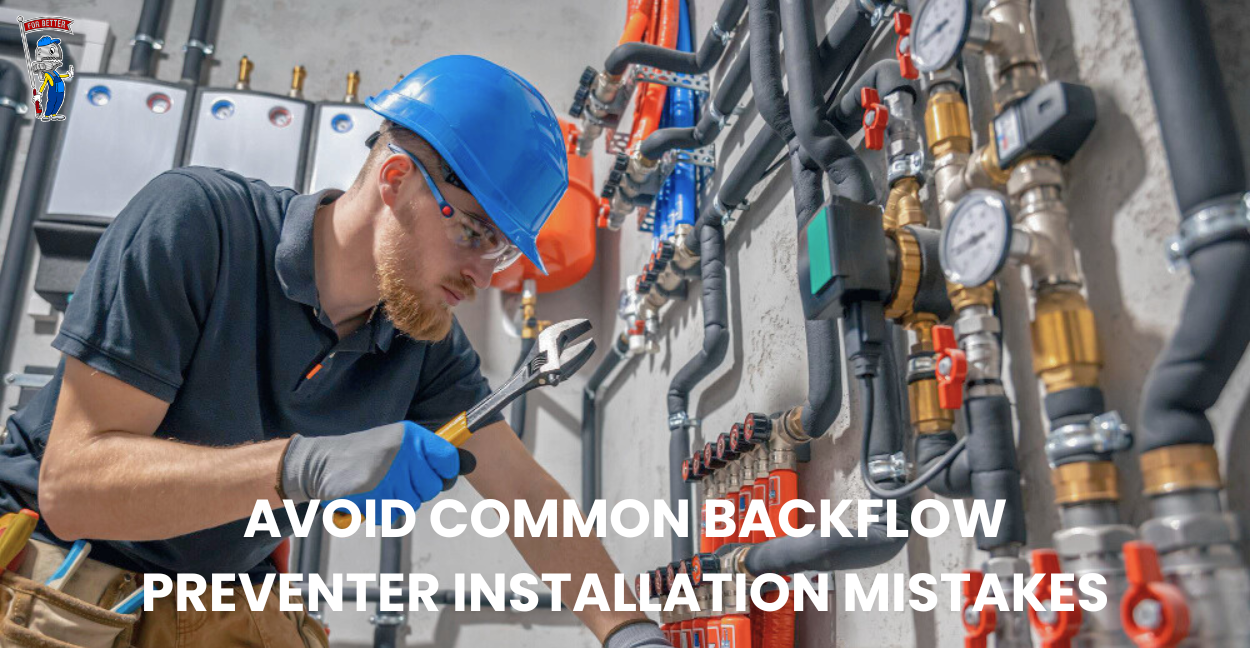When it comes to maintaining a safe and clean water supply, one critical component is the backflow preventer. This device ensures that contaminated water does not flow back into the clean water supply, protecting both health and infrastructure. However, backflow preventer installation mistakes can compromise the system’s effectiveness, leading to potential hazards. In this article, we’ll explore common installation errors, their consequences, and how to avoid them.
Introduction to Backflow Preventers
Backflow preventers are essential devices installed in plumbing systems to prevent the reverse flow of water. This is crucial in preventing contaminants from entering the potable water supply. These devices are especially important in commercial, industrial, and residential settings where cross-connections might occur.
8 Common Backflow Preventer Installation Mistakes
When installing a backflow preventer, there are several common mistakes that can compromise its effectiveness and lead to serious issues. Understanding these mistakes and how to avoid them is crucial for ensuring the safety and reliability of your water supply system. Here, we will discuss these mistakes in detail.
1.) Incorrect Sizing
Incorrect sizing is one of the most frequent mistakes made during backflow preventer installation. Using a backflow preventer that is either too small or too large for the specific application can lead to various problems. If the device is too small, it may restrict water flow, causing a drop in pressure and potentially damaging the plumbing system. On the other hand, an oversized device might not effectively prevent backflow, compromising water safety.
Solution: Always ensure that the backflow preventer is properly sized according to the system’s flow rate and pressure requirements. Consulting with a professional or referring to the manufacturer’s specifications can help determine the correct size for your application.
2.) Improper Location
The location of the backflow preventer is crucial for its performance and maintenance. Installing the device in an inaccessible or inappropriate area can hinder routine inspections and repairs. Additionally, placing it in areas prone to flooding or where it can be easily damaged can reduce its lifespan and effectiveness.
Solution: Choose a location that is easily accessible for maintenance and testing. Ensure the site is protected from physical damage and extreme weather conditions, particularly freezing temperatures, which can cause the device to malfunction.
3.) Neglecting Manufacturer Instructions
Each backflow preventer comes with specific installation guidelines provided by the manufacturer. Neglecting these instructions can lead to improper installation, which may void warranties and result in the device not functioning correctly. This mistake often arises from a lack of attention to detail or an attempt to expedite the installation process.
Solution: Always follow the manufacturer’s instructions meticulously. These guidelines are designed to ensure the backflow preventer operates correctly and safely. Pay attention to details such as orientation, connection methods, and any special installation requirements.
4.) Skipping Initial Testing
After installing a backflow preventer, it’s essential to test it to ensure it’s working correctly. Skipping this initial testing step can leave undetected issues that compromise the system’s safety, leading to potential backflow incidents.
Solution: Conduct comprehensive tests immediately after installation. This includes pressure testing and verifying that the backflow preventer is effectively preventing reverse flow. Any detected issues should be addressed promptly to ensure the system’s integrity.
5.) Inadequate Maintenance Planning
A backflow preventer requires regular maintenance to remain effective. Inadequate maintenance planning can lead to the device failing when needed most. Many installations overlook the importance of establishing a regular maintenance schedule, resulting in neglected devices that eventually malfunction.
Solution: Develop a maintenance plan that includes regular inspections and testing based on the manufacturer’s recommendations and local regulations. Keeping a maintenance log can help track the condition of the backflow preventer and ensure timely servicing.
6.) Incorrect Orientation
Backflow preventers are designed to work in specific orientations. Installing the device incorrectly can impede its function, leading to ineffective backflow prevention. This mistake is often due to a misunderstanding of the installation requirements or a lack of attention to detail.
Solution: Follow the orientation instructions provided by the manufacturer. Ensure that the device is installed in the correct position, as specified in the installation manual, to facilitate proper operation.
7.) Failure to Install Isolation Valves
Isolation valves are critical for the maintenance and testing of backflow preventers. Failing to install these valves can make it difficult to isolate the device for maintenance, leading to complications during repairs and testing.
Solution: Install isolation valves on both sides of the backflow preventer. These valves allow for easy isolation of the device, facilitating maintenance and testing without disrupting the entire system.
8.) Poor Protection from Freezing
In regions with cold climates, freezing can be a significant issue for backflow preventers. If the device is not adequately protected, it can freeze and fail, leading to potential backflow and contamination of the water supply.
Solution: Ensure the backflow preventer is installed in a location that is protected from freezing temperatures. If this is not possible, use insulation or heating elements to prevent the device from freezing and ensure it remains operational throughout the winter months.
Consequences of Installation Mistakes
Proper installation of backflow preventers is critical to maintaining a safe and reliable plumbing system. When mistakes are made during installation, the consequences can be severe, impacting both the functionality of the system and the health and safety of the users. Now, we will explore five major consequences of installation mistakes in detail.
Contamination of Potable Water Supply
One of the most significant consequences of backflow preventer installation mistakes is the contamination of the potable water supply. If the backflow preventer is not installed correctly, it can fail to prevent reverse flow, allowing pollutants and contaminants to enter the clean water system. This contamination can occur from various sources, including pesticides, chemicals, and bacteria from irrigation systems, industrial processes, and other non-potable water sources.
Health Risks to Consumers
The contamination of potable water due to improper backflow preventer installation poses significant health risks to consumers. Exposure to contaminated water can lead to various illnesses, ranging from mild gastrointestinal issues to severe bacterial infections and chemical poisoning. Vulnerable populations, such as children, the elderly, and individuals with compromised immune systems, are particularly at risk.
Legal and Regulatory Repercussions
Improper installation of backflow preventers can lead to non-compliance with local, state, and federal regulations. Regulatory bodies have stringent requirements for the installation and maintenance of backflow prevention devices to ensure public safety. Failure to comply with these regulations can result in legal actions, fines, and penalties.
Increased Maintenance and Repair Costs
Mistakes during the installation of backflow preventers can result in increased maintenance and repair costs over time. An improperly installed device is more likely to fail, requiring frequent repairs or replacement. Additionally, undetected issues can lead to more extensive damage to the plumbing system, escalating maintenance costs.
System Downtime and Operational Interruptions
Backflow preventer failures due to improper installation can cause significant system downtime and operational interruptions. When a backflow preventer malfunctions, it may necessitate shutting down the water supply to address the issue, disrupting daily operations in residential, commercial, and industrial settings.
Best Practices for Installing Backflow Preventers
To avoid these issues, follow these best practices:
- Always choose the appropriate size based on the system’s specifications.
- Install the device in an accessible, protected location.
- Adhere to all instructions provided by the manufacturer.
- Perform tests post-installation to ensure proper functionality.
- Implement a regular maintenance and testing schedule.
FAQs
1.) How do I choose the right type of backflow preventer for my system?
Choosing the right type of backflow preventer depends on various factors such as the specific requirements of your water system, local regulations, and the level of protection needed. It’s recommended to consult with a professional plumber or backflow prevention specialist who can assess your system’s needs and recommend the appropriate type of backflow preventer. Factors to consider include the type of contaminants present, water pressure, flow rate, and the system’s overall configuration.
2.) What are the signs of a poorly installed backflow preventer?
Signs of a poorly installed backflow preventer may include:
- Leaks: Visible leaks around the device or in the plumbing system can indicate installation issues.
- Unusual Noises: Strange sounds, such as banging or rattling, during water flow could signal a problem with the preventer.
- Decreased Water Pressure: A drop in water pressure throughout the system may indicate a blockage or malfunction in the preventer.
- Visible Damage: Physical damage to the backflow preventer, such as cracks or breaks, is a clear sign of installation or maintenance issues.
3.) How often should I test my backflow preventer?
It’s generally recommended to test your backflow preventer annually. However, the frequency of testing may vary based on local regulations and the type of backflow preventer installed. Some jurisdictions require more frequent testing, such as semi-annual or quarterly tests, especially for high-risk systems or critical facilities like hospitals or industrial sites. Regular testing ensures that the backflow preventer is functioning correctly and providing the necessary protection.
Contact Backflow Services Done Right
Protect your water supply by ensuring your backflow preventer is installed and maintained correctly. Contact us today for professional installation and maintenance services to safeguard your system from contamination and ensure compliance with regulations.



